Here’s your weekly roundup of local and international climate change news for the week of Sept. 25 to Oct. 1, 2023.
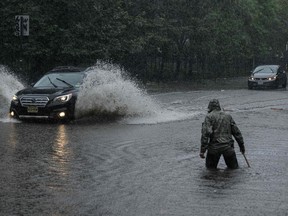
Article content
This week, New York experienced record rainfall and flooding as students rallied in Montreal demanding an end to the use of fossil fuels. And, Alberta became the first jurisdiction to use an AI tool to analyze wildfire data in a bid to determine how it is linked to carbon emissions, climate change, fire and human behaviour.
Here’s all the latest news concerning the climate crisis, biodiversity loss, and the steps leaders are taking to address these issues.
Advertisement 2
Article content
Article content
In climate news this week:
• Nearly $1 billion in wildfire costs helps to push B.C.’s projected deficit to $6.7B
• Students gather in Montreal to rage against threat of climate change
• Record rainfall and flooding in New York
• Canadian farmers reel from drought and heat
Since the 1800s, human activities have been the main driver of climate change, mainly because of burning of fossil fuels like coal, oil and gas, which produces heat-trapping gases.
The UN’s Intergovernmental Panel on Climate Change has warned for decades that wildfires and severe weather, such as B.C.’s deadly heat dome and catastrophic flooding in 2021, would become more frequent and more intense because of the climate emergency.
The panel has issued a “code red” for humanity and last year it said the window to stop global warming from exceeding 1.5 C was closing. In April 2022, it released a report with solutions for how to drive down greenhouse gas emissions, mainly by transitioning away from fossil fuels.
Research shows that the warmer, drier conditions are leading to increased drought, which exacerbates the wildfire situation. Whether the cause is human or lightning, many of the planet’s tinder-dry forests are igniting earlier in the season because of global heating.
Article content
Advertisement 3
Article content
Climate change quick facts:
- The Earth is now about 1.2 C warmer than it was in the 1800s.
- Globally, 2022 was the fifth hottest year on record, while 2016 was the hottest.
- Human activities have raised atmospheric concentrations of CO2 by nearly 49 per cent above pre-industrial levels starting in 1850.
- The world is not on track to meet the Paris Agreement target to keep global temperature from exceeding 1.5 C above pre-industrial levels, the upper limit to avoid the worst fallout from climate change.
- On the current path of carbon dioxide emissions, the temperature could increase by as much as 4.4 C by the end of the century.
- In April, 2022 greenhouse gas concentrations reached record new highs and show no sign of slowing.
- Emissions must drop 7.6 per cent per year from 2020 to 2030 to keep temperatures from exceeding 1.5 C and 2.7 per cent per year to stay below 2 C.
- 97 per ent of climate scientists agree that the climate is warming and that human beings are the cause.
(Source: United Nations IPCC, World Meteorological Organization, UNEP, Nasa, climatedata.ca)
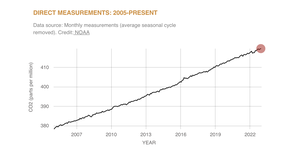
Latest News
Nearly $1 billion in wildfire costs helps to push B.C.’s projected deficit to $6.7B
A record-high $966 million in wildfire spending and lower natural gas prices have added $2.5 billion to British Columbia’s projected deficit for this fiscal year.
The new projection of $6.7 billion comes as Finance Minister Katrine Conroy releases the province’s first-quarterly report for 2023-2024.
The report says updated wildfire expenses are $762 million more than planned for in Budget 2023, while revenue from natural gas royalties fell by $1.2 billion as prices declined.
Conroy says the province had already taken into account a possible drop in natural gas revenue in this year’s budget projections, but didn’t anticipate prices dropping as much as they did.
The minister has dismissed the possibility of cutting services or adding new taxes to balance the budget, saying provincial officials know that maintaining spending works to boost the economy.
Read the full story here.
—The Canadian Press
New York begins drying out after being stunned and soaked by record-breaking rainfall
New York City began drying out Saturday after being soaked by one of its wettest days in decades, as city dwellers dried out basements and traffic resumed on highways, subways and airports that were temporarily shuttered by Friday’s severe rainfall.
Record rainfall — more than 8.65 inches (21.97 centimeters) _ fell at John F. Kennedy International Airport, surpassing the record for any September day set during Hurricane Donna in 1960, the National Weather Service said.
Parts of Brooklyn saw more than 7.25 inches (18.41 centimeters), with at least one spot recording 2.5 inches (6 centimeters) in a single hour, turning some streets into knee-deep canals and stranding drivers on highways.
The deluge came less than three months after a storm caused deadly floods in New York’s Hudson Valley and swamped Vermont’s capital, Montpelier.
As the planet warms, storms are forming in a hotter atmosphere that can hold more moisture, making extreme rainfall more frequent, according to atmospheric scientists.
Read the full story here.
—The Associated Press
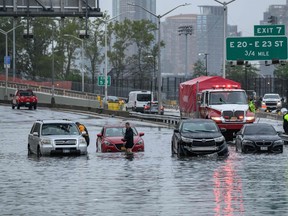
Advertisement 4
Article content
Storm floods subways, highways and streets in New York City, area under state of emergency
A potent rush-hour rainstorm swamped the New York metropolitan area on Friday, shutting down parts of the city’s subway system, flooding streets and highways, and delaying flights into LaGuardia Airport.
Up to 13 centimetres of rain fell in some areas overnight, and as much as 18 centimetres more was expected throughout the day, New York Gov. Kathy Hochul said Friday morning.
By midday, although there was a break in the clouds, Mayor Eric Adams urged people to stay put if possible.
“It is not over, and I don’t want these gaps in heavy rain to give the appearance that it is over,” he said at a news briefing. He and Hochul, both Democrats, declared states of emergency.
—The Associated Press
Students gather in Montreal to rage against threat of climate change
Hundreds of people attended a climate demonstration that started at the foot of Mount Royal on Friday.
Chanting “The street is ours” and “Fossil fuels have got to go,” groups of students from several schools, including Dawson College, CEGEP St-Laurent and Concordia University, blocked Parc Ave. in front of the George-Étienne Cartier monument as they gathered for the “Climate Rage” march.
“I’m worried. I’m worried for my daughter,” said Heather Sheppard, who travelled by bike from Longueuil to join the march.
“End fossil fuels. Not our kids’ futures,” her sign said.
There was a heavy police presence. However, the protest was largely peaceful.
Marielle Lauzon-Poirier, an Ontario student, came to Montreal for the week-long Climate Rage events. She brought her dog, Tofu, and a sign to Friday’s demonstration: “I’m afraid for the future.”
Read the full story here.
—Montreal Gazette
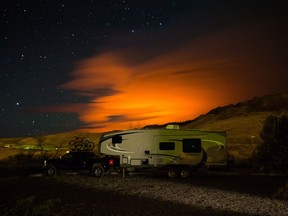
Advertisement 5
Article content
B.C.’s 2017 Elephant Hill Fire caused accelerated erosion in river near Cache Creek: UBC study
A UBC Okanagan study on the impact of wildfires on watersheds has found that the 2017 Elephant Hill wildfire caused accelerated erosion in a river near Cache Creek.
Alessandro Ielpi, an assistant professor in geomorphology, says the Bonaparte River widened up to 130 per cent and the erosion pace increased by an estimated 230 per cent.
“In some parts it has widened to more than twice its original size,” he said Wednesday.
His research, published in CATENA and done in collaboration with Mathieu Lapôtre at Stanford University, also noted that local people noticed a change in salmon and trout spawning beds and an increase of river silt after the fire, according to UBC.
“The water became much more cloudy with sediment, and that is something that affects fish health…the gills get clogged with with fine sediment and they don’t work as well as they would do in clear water,” he said, adding that these are observations based on conversations with local residents.
Read the full story here.
—Tiffany Crawford
Canadian farmers expected to plant most wheat since 2001 as drought, war hit global supplies
Canadian farmers intend to plant the most wheat in 22 years, a government report said on April 26, as the war in Ukraine and drought in the United States tighten global supplies.
Global stocks of wheat and vegetable oil have been limited by obstacles facing Ukraine’s exports, and Russia has signalled it may not allow a deal securing a safe Black Sea grain corridor to extend beyond May 18.
Winter wheat ratings in the United States, the world’s fifth-largest exporter, are the lowest since 1989 due to drought.
Statistics Canada forecast all-wheat plantings at 27 million acres, up six per cent from last year and exceeding the average industry expectation of 26.3 million. That would be the biggest wheat area since 2001.
Read the full story here.
—Reuters
Agricultural disasters’ spread in Alberta, but local leaders say Ottawa’s ignoring requests for help
Droughts in the West have so far prompted at least 13 districts in Alberta to declare agricultural disasters, but appeals to the federal Liberal government for assistance to the province’s farmers, livestock producers and ranchers are being ignored say local leaders.
On Wednesday, the Municipal District of Pincher Creek, tucked into the southwest corner of Alberta between the Crowsnest Pass and Fort Macleod, became the latest jurisdiction to declare a state of agricultural disaster.
“Drought conditions impacted 50 to 90 per cent of crops, pasture, and range yields in the MD of Pincher Creek due to a lack of spring and in-season moisture combined with long durations of high temperatures and winds,” read the declaration advisory.
Rick Lemire, reeve of the MD of Pincher Creek, said a hot, dry summer has created a nightmare scenario for local farmers and ranchers.
“Things have deteriorated quite a bit in the last month with the crazy heat and the lack of moisture,” he said.
Read the full story here.
—Bryan Passifiume, National Post
Alberta turns to artificial intelligence to outsmart wildfires
With wildfires torching record swaths of forest and increasingly volatile, those directing the fight against them can be hard-pressed to make the best decisions.
As the stakes in making those early, crucial choices rise, Alberta has become the first jurisdiction in North America to augment human intuition with artificial intelligence in the war against wildfires that have charred at least two million hectares of woodland in the province this year.
“If you’ve got less experience and when (the situation is) more ambiguous, it can be pretty tough to make the call in deploying firefighting resources,” said Chantal Ritcey, executive business partner with Edmonton-based AltaML which is partnering with the province in reinforcing wildfire fighters with AI.
In the summer of 2022, Alberta Wildfire piloted the wildfire occurrence prediction system, a tool that’s been put to far greater use this year in taming dozens of blazes throughout the province’s forestry protection zones.
The tool absorbs more than three decades of wildfire data, along with connecting the dots between daily carbon emissions, climate change, fire and human behaviour.
Read the full story here.
—Bill Kaufmann, The Calgary Herald
Social Media
Advertisement 6
Article content
Advertisement 7
Article content
A glance at carbon numbers:
- B.C.’s gross greenhouse gas (GHG) emissions in 2020 (latest available data) were 64.6 million tonnes of carbon dioxide equivalent (MtCO2e). This is a decrease of 0.9 MtCO2e (one per cent) from 65.5 MtCO2e in 2007, the baseline year for emissions reduction targets.
- B.C.’s net greenhouse gas (GHG) emissions in 2020 were 63.5 million tonnes of carbon dioxide equivalent (MtCO2e.) This is a net decrease of 2.0 MtCO2e, or three per cent, since 2007.
- B.C.’s net emissions in 2019: 67.2 MtCO2e, an increase of 1.5 MtCO2e, or two per cent, since 2007.
- B.C. does not include emissions from wildfire smoke in its calculations.
- B.C.’s 2030 target: 40 per cent reduction in net emissions below 2007 levels.
- B.C.’s 2040 target: 60 per cent reduction.
- B.C.’s 2050 target: 80 per cent reduction.
- Canada’s greenhouse gas emissions in 2021 were 670 million tonnes, up from 659 million tonnes in 2020.
- Canada’s 2030 emissions target: Between 40 and 45 per cent reduction.
- Canada’s 2050 emissions target: Net-zero.
GUIDES AND LINKS
It’s official: El Niño has started. Here’s what that means for B.C.
B.C. Flood: Read all our coverage on the Fraser Valley and beyond
Frequently asked questions about climate change: NASA
Climate change made B.C. heat wave 150 times more likely, study concludes
B.C.’s heat wave: Intense weather event is linked to climate crisis, say scientists
Expert: climate change expected to bring longer wildfire seasons and more area burned
COVID-19 may have halted massive protests, but youth are taking their fight for the future to the courts
Climate displacement a growing concern in B.C. as extreme weather forces residents out of their homes
Do you know someone who is doing something positive in the fight against climate change? Please email ticrawford@postmedia.com with story ideas and tips.
Bookmark our website and support our journalism: Don’t miss the news you need to know — add VancouverSun.com and TheProvince.com to your bookmarks and sign up for our newsletters here.
You can also support our journalism by becoming a digital subscriber: For just $14 a month, you can get unlimited, ad-lite get unlimited, ad-lite access to The Vancouver Sun, The Province, National Post and 13 other Canadian news sites. Support us by subscribing today: The Vancouver Sun | The Province.
Article content










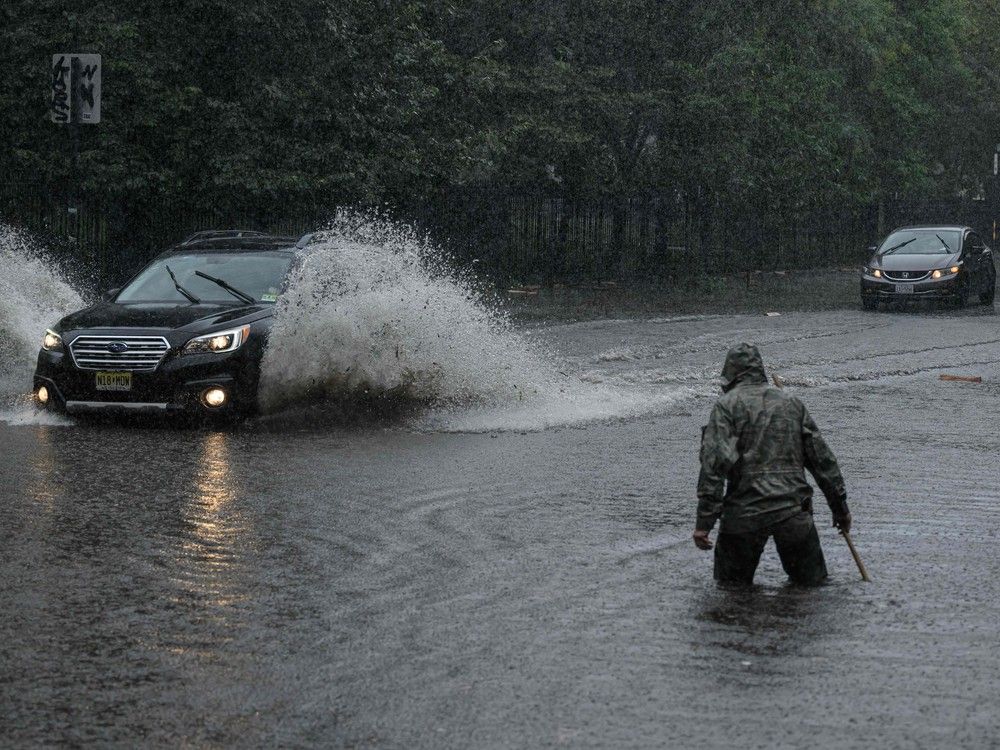










Discussion about this post